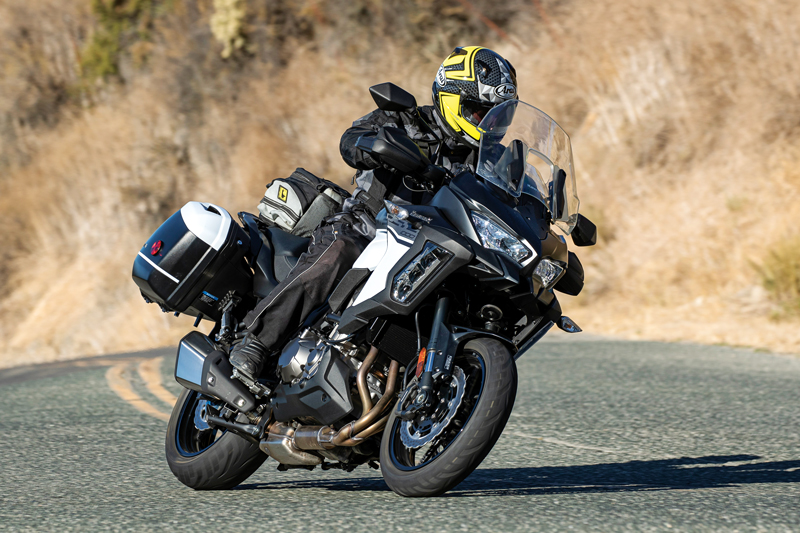
Considering how popular the Versys 650 has become, almost from the moment it was introduced in the U.S. for 2008, we found it decidedly strange that Kawasaki only blessed Europe and Asia with the larger Versys 1000 when it appeared for 2012. OK, the styling was funky, but it had great bones, and when Team Green finally redesigned and brought it stateside for 2015 as the Versys 1000 LT, we liked it so much we gave it our Motorcycle of the Year award…and wore the tires off our long-term test bike. Here was a motorcycle that combined all of the good traits of adventure bikes — comfortable, upright seating; compliant, longer-travel suspension; good wind protection and moderate weight — with performance and handling near that of a liter-class sport-touring machine. In short, a sport-adventure “VERsatile SYStem” for riders with little or no off-road aspirations.
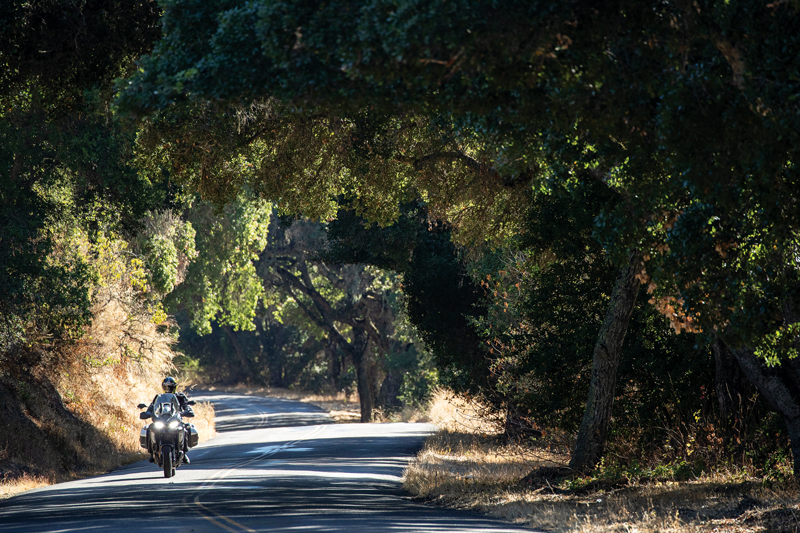
By retuning the liquid-cooled, 1,043cc DOHC in-line four from the Ninja 1000 to create a table-flat torque curve for better touring manners — without sacrificing much of the Ninja’s screaming top-end hit that is catnip to sport-oriented riders — the Versys 1000 LT package could handle rough back roads or smooth highways, long two-up tours or commuting, a sedate group ride or a tire-shredding rip up a canyon road. As a more comfortable alternative to the Ninja 1000, including plusher passenger accommodations, Kawasaki further sweetened the Versys 1000 LT deal with standard saddlebags, an adjustable windscreen, a centerstand, hand guards and a luggage rack. The only complaint we had is a common one among adventure-styled bikes — a tall 33-inch seat height — but a ¾-inch lower accessory seat is available, and the stocker is so thickly padded it’s easily reworked.
The clincher was the Versys 1000 LT’s price of just $12,799 in 2015, well below the competition despite its similar features and standard saddlebags.

Fast forward to 2018, and the (love it or hate it, it’s here to stay) era of electronic rider aids was bypassing the basic-but-just-$12,999 big Versys, which only offered ABS, traction control and two power modes (Full and Low) for the button addicts. So for 2019 Kawasaki took the bold step of raising the new Versys 1000 SE LT+ price to $17,999, and filled the $5,000 gap with semi-active electronically controlled suspension, throttle-by-wire, cruise control, a quickshifter, heated grips, inertial measurement unit (IMU)-based 6-axis input for the now multi-level traction control and cornering ABS, four integrated ride modes that link to the suspension, TC and power levels, and LED head, tail and cornering lights. The command/control window into all of it is a bright, new multi-function TFT display with Sport, Touring and night modes as well as Bluetooth smartphone connectivity via Kawasaki’s Rideology app. The TFT display shares dash space with a big analog speedometer and a 12V, 45-watt accessory socket.
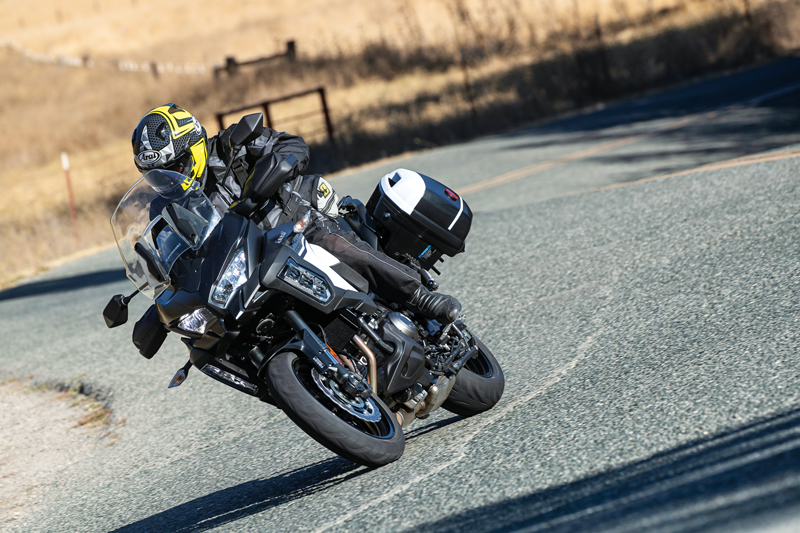
Drilling down into the technical minutiae of each electronic feature is best left to the thick owner’s manual, but a few are worth detailing here, such as the Cornering Management function that uses both ABS and TC — with input from the IMU — to “assist” a rider experiencing sudden acute pucker factor to hold an intended line through a corner. I did not try this, and don’t ask me to. And the ride modes are a well thought-out platter of Sport, Road, Rain and customizable Rider choices that select either Full or Low power delivery (both of which are smooth and linear, with no annoying throttle abruptness), three levels of TC or TC off, and Hard, Normal or Soft suspension damping (rear spring preload is set separately). For example, Sport selects Full power, minimal TC and Hard suspension. In the Rider mode (our favorite, of course), you can set your own combinations, and fine-tune each of the suspension’s three damping settings. Finally, a comprehensive menu display gives you adjustment and on/off control over things like the quickshifter, cornering lights, shift light, etc.
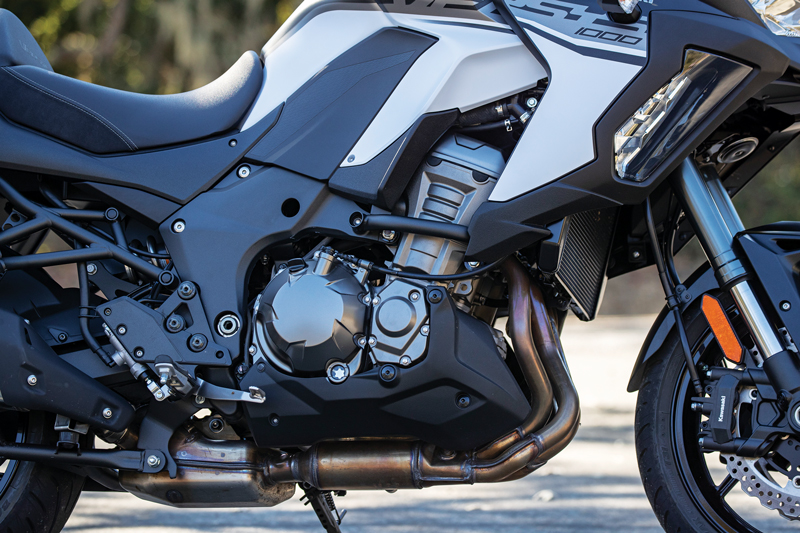
Since all of this stuff is hung on essentially the same basic powertrain, chassis and running gear from 2015-2018, you can fire up the Versys 1000 SE LT+ and without even looking at the instrument panel enjoy its broad, smooth powerband, roomy comfortable ergonomics, good wind protection and exceptional braking. The fairing is a bit broader and more protective now due to the cornering lights, its 17-inch wheels front and rear with sport-touring rubber give the bike good grip and sweet, stable handling, and it has plenty of cornering clearance. Our 2019 test bike made similar power output numbers to our 2015 model (see the dyno chart), which makes sense, since the counterbalanced engine is unchanged. And Kawasaki Electronically Controlled Suspension (KECS) is a sweet addition, mainly because it adjusts damping in the new high-end cartridge fork and BFRC (Balance Free Rear Cushion) lite rear shock in real time depending upon conditions, and lets you quickly change the overall stiffness of the suspension for a softer or firmer ride.

Mark’s Gear
Helmet: Arai Signet-X
Jacket: Olympia Richmond
Pants: Olympia X Moto 2
Boots: Dainese Long Range
I was less impressed with the new cruise control, which didn’t hold the bike’s speed well, and wasn’t immediately responsive to attempts to raise or lower the set speed. The quickshifter is also a disappointment — though it works adequately it lacks the crispness of other up/down quickshifters and had a vague, mushy feeling at the shift lever. New owners may also be frustrated by the learning curve required to display information and make vehicle menu selections, which is not at all intuitive. Changing ride modes on the fly in particular needs a rethink, since you must close the throttle for far too long to do so.
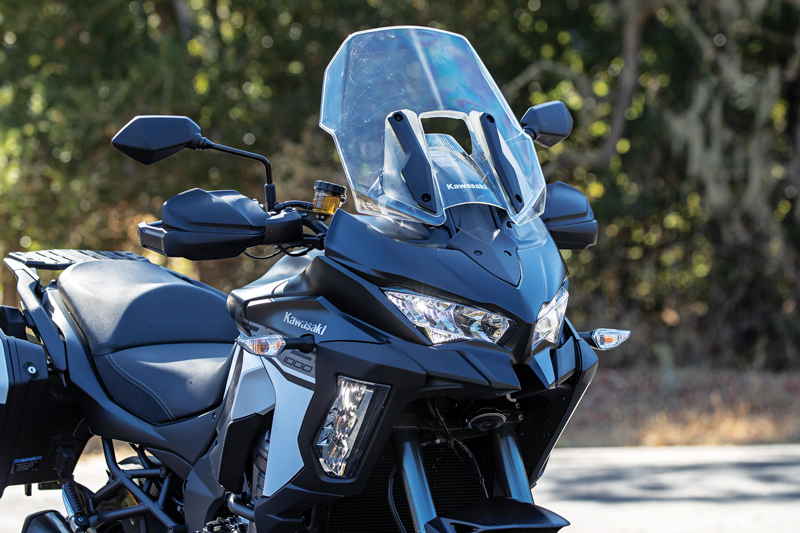
OK, though some of its new features are still a work in progress, there’s a lot to like about the Versys 1000 SE LT+. The seats are plush, the new heated grips work great and the mirrors, windscreen, adjustable brake and clutch levers and LED cornering lights are all very functional. Can’t say enough about the locking saddlebags either, each of which holds 29 liters or a full-face helmet and can be removed and installed in a snap (and you can add a 47-liter accessory top case). Load capacity and alternator output are quite good, and the bike pops right onto its centerstand with little effort, a remarkable achievement for any nearly 600-pound motorcycle. Ride it on Low power with a tame wrist and you should easily top 45 mpg and 250 miles from the 5.5-gallon tank, though it does require premium fuel.
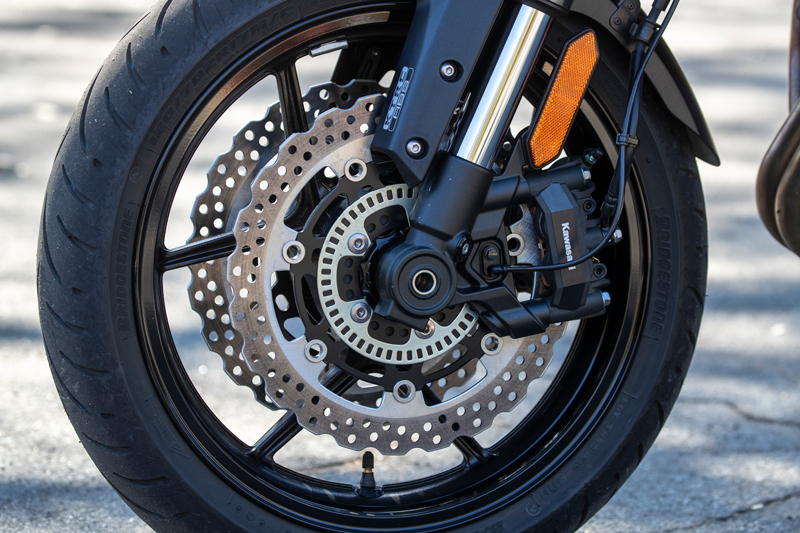
As an adventure-styled motorcycle with a 17-inch front wheel and no real off-road ambitions, the Versys 1000 SE LT+ is unique among liter-class Japanese ADV bikes, which generally have a 19- or 21-inch front, more ground clearance, undercarriage protection, etc. That Kawasaki chose to fit the new Versys with a raft of contemporary electronic features before the latest Concours 14 sport tourer demonstrates how hot adventure bikes have become — if not actual ADV riding — and makes it even more road ready. For 2020 the Versys will be offered in eye-popping Emerald Blazed Green/Pearl Storm Gray rather than the Metallic Flat Spark Black/Pearl Flat Stardust White of our 2019 test bike, and we can’t wait to see it…especially if it’s from the saddle.
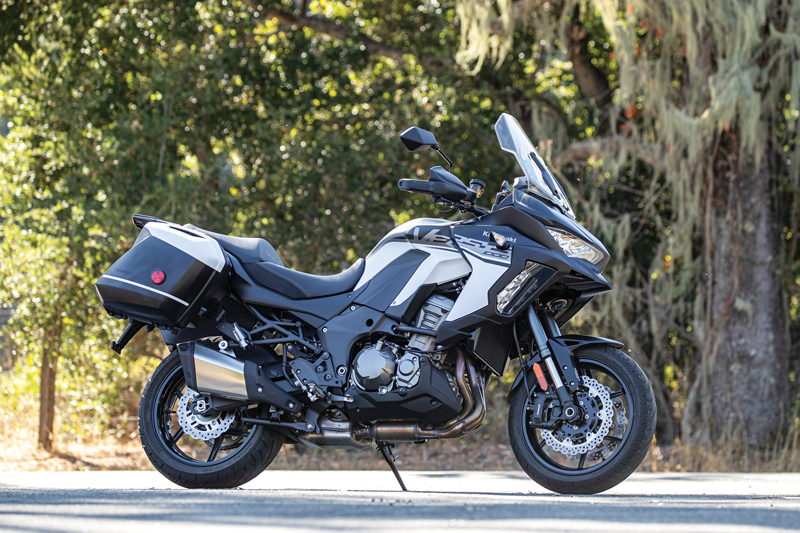
2019 Kawasaki Versys 1000 SE LT+ Specs
Base Price: $17,999 (2020 model)
Warranty: 2 yrs., unltd. miles
Website: kawasaki.com
Engine
Type: Liquid-cooled, transverse in-line four
Displacement: 1,043cc
Bore x Stroke: 77.0 x 56.0mm
Compression Ratio: 10.3:1
Valve Train: DOHC, 4 valves per cyl.
Valve Insp. Interval: 15,200 miles
Fuel Delivery: DFI w/ Keihin 38mm ETV throttle bodies x 4
Lubrication System: Wet sump, 4.2-qt. cap.
Transmission: 6-speed, hydraulically actuated wet assist-and-slipper clutch
Final Drive: O-ring chain
Electrical
Ignition: TCBI w/ digital advance
Charging Output: 407 watts max.
Battery: 12V 8.2AH
Chassis
Frame: Twin-spar aluminum w/ engine as stressed member, tubular-steel subframe & cast aluminum swingarm
Wheelbase: 59.8 in.
Rake/Trail: 27 degrees/4.2 in.
Seat Height: 33.1 in.
Suspension, Front: 43mm USD fork, KECS fully adj., 5.9-in. travel
Rear: Single back-link shock, KECS fully adj., 5.9-in. travel
Brakes, Front: Dual 310mm petal discs w/ opposed 4-piston calipers & ABS
Rear: Single 250mm petal disc w/ 1-piston caliper & ABS
Wheels, Front: Cast, 3.50 x 17 in.
Rear: Cast, 5.50 x 17 in.
Tires, Front: 120/70-ZR17
Rear: 180/55-ZR17
Wet Weight: 584 lbs.
Load Capacity: 470 lbs.
GVWR: 1,054 lbs.
Performance
Fuel Capacity: 5.5 gals., last 1.0 gal. warning light on
MPG: 90 AKI min. (low/avg/high) 33.8/39.1/41.7
Estimated Range: 215 miles
Indicated RPM at 60 MPH: 3,600
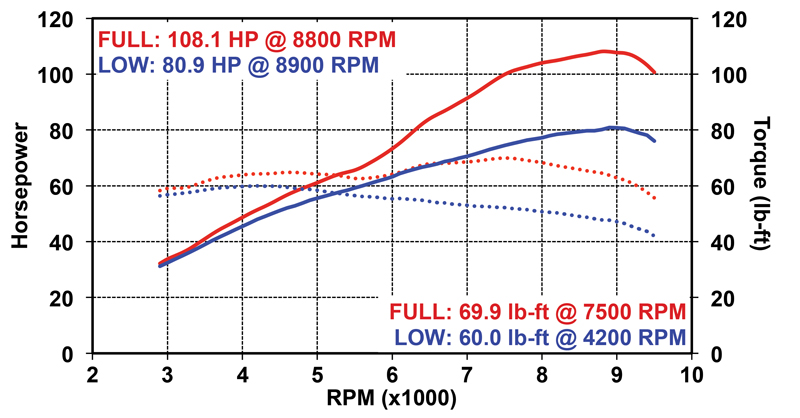









Great review and it is exactly as the article describes the bike. Mine was purchased July 2019 and is my 41st motorcycle that I have owned. Hadn’t had a Kawasaki in a while…and it is typical Kawasaki. Has a mean growl to it at full throttle, rides nice, but has a little bit of gear noise from the straight cut gears, and a little clatter from the engine at idle…as stated, just like a Kawasaki!
That being said, the electronics are amazing on the bike. First, the modes really change the character of the bike, so power output, braking, cornering KTRAC and KIBS comes on based on all the parameters for leaning, acceleration and deceleration…it works quite well should I say! The suspension is what I like the most, as the roads aren’t always smooth from the harsh winters, and the bike can be tuned for a nice ride and if you want to make it a harsh ride…it truly works amazingly well.
After riding my Road King back to back with the Versys 1000, I can say that they are two unique motorcycle platforms. The Road King…sedate and filled with attitude, while the Kawasaki is – well, a traveling machine! If I were to ride to one coast or the other, hands down the Kawasaki would be the bike of choice!
I agree. I traded a Road King in on my 2015 Versys and there is no comparison. Been riding since 1963, and this was my first Harley. It will prove to be my last, also.
My 2015 has never seen a drop of premium fuel and runs great.
So let me get this straight. The lame little $8,000 Vulcan has “Ergo Fit” handlebars, and this near $20,000 bike doesn’t. Is that correct?? I own 4 bikes now and have owned over 100 bikes in my life. I have a 2015 Versys 1000. It’s the best of all the bikes with one MAJOR exception. I find it inexcusable that they don’t have handlebars that can adjust up and back, or at least extend the cables and brake lines so I can install bar risers. I’m 6′”1 and my sons are 6’5″, and for us the bars are to low. The brake line is so tight I can’t even add 1″ risers on this bike, and they welded it so I can add an extension. I hope that for the extra $5,000 they at least made the cables and brake lines longer. If not, someone at Kawasaki should be fired! This is almost the perfect bike, and for the lame reason of not making a few cables 2 inches longer it completely misses the mark. Hey Kawasaki, are you listening??? We are not all little 5″4 riders here in America!
Ron, I know I am replying to an old 2-year post, but I own a 2021 Versys 1000 SE LT+ and was easily able to add a set of 2” Rox Risers last year without any modification or cable re-routing. I can go from lock to lock without any clutch, electrical cable or brake line stress.
This barely has anything to do with the Versys 1000 SE LT+, but it hit me while reading this review. Like others posting comments here, I’m a long time rider thats owned many bikes. However, I’ve only owned one Kawasaki way back in the last century; I’ve been a Suzuki and Honda guy, although I did serve a long sentence with a BMW. Anyway, it struck me as odd that situations like mine are fairly common. Why do many of us stick with some manufacturers and ignore other, equally good, manufacturers? It remains a mystery. I’ll likely never buy or even demo a Versys 1000 SE LT+, and it has nothing to do with the bike. Like my first love said as I was being dumped, sorry Kawasaki, it’s not you, it’s me.
Like others I have been at this awhile but not had a Kaw since they were 2 strokes. This bike does hit some good buttons for me with the cruise, bags and upright seating so you can stand on the pegs now and then. Suspect it would run on regular in the 80hp mode. Getting old for tall adv setup, riding my vstrom 650 less and Vstar 1300 more but not loving the cruiser feet forward position for long distances. Was considering Concours when I saw this. With 17″ front wheel this really is a road bike and I would look at it seriously if seat was more like 31″. Price seems about $2000 too high but think I’ll at least give a look. I know you can get links to lower the vstrom.
I have a 2019 Versys SE LT+. I really like the bike. This is a pretty accurate review, except the part about the “plush” seat. It may look good and it may be about as good as many stock seats but after 2 hours I need to get off and rest my sore butt. It a shame that manufacturers make a bike that cost thousands of dollars and put a cheap, uncomfortable seat on it. If a car manufacturer did this, they wouldn’t barely sell!
You could have mentioned the heat that comes off the engine on a hot day in traffic, but this is only uncomfortable if stopped for any length of time.
Sorry. I just left a review and fat fingered my e-mail:(
I own one and it’s a great bike. I have 119 bikes in total now. I love it though☺